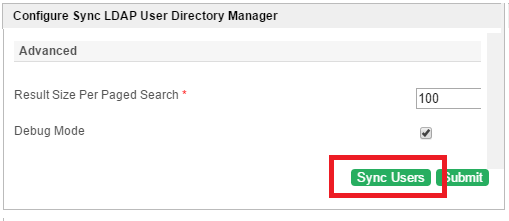Introduction
The Sync LDAP User Directory Manager is a hybrid solution that allows you to make use of the user objects from your organization's LDAP server and maintaining organization structure (organization / department / group) locally inside Joget.
This plugin allows you to import user objects from LDAP server on demand into Joget built in user directory manager to reduce its dependency on the LDAP server for improved performance.
The built in user directory manager is still the primary handler when this plugin is activated. Once you have synchronized the users to the local directory manager, you can assign the users to your organization/department/group/grade which created locally.
With the use of this plugin, we will be able to reduce the conventional load and dependency on the LDAP server and to only use it for authentication purpose.
A new feature added in Joget DX is the "Auto schedule sync" property. The Joget admin can also click on the Sync Users button to manually perform an LDAP sync.
Joget identifies users on Sync LDAP if the password column in database is "(NULL)", which causes the following to take place:
- Users cannot edit their profile.
- Admin cannot use @"Admin Bar > Users > Setup User"@ to edit user information.
- Only records with password equal NULL will sync to your LDAP directory.
If the user wants to change his password, recommended is to change it in LDAP/AD.
Sync LDAP Properties
Configuring Sync LDAP
Figure 1: Configure Sync LDAP
Figure 2: Sync Organization Enabled
| Name | Description / Sample Value | ||||||
|---|---|---|---|---|---|---|---|
| URL | |||||||
Admin Username (Principal) | cn=admin,dc=joget,dc=org | ||||||
Admin Password (Credential) | Input the admin password for your LDAP/AD. | ||||||
| Root DN | Set the root DB, for example "eg. DC=Joget,DC=org". | ||||||
| Sync Organization | New Feature This is a new feature in Joget DX. Perform synchronization not just to user objects, but to the whole organizational structure including Group, Department, Grade as well. By enabling this feature, you will need to configure the following as well.
Please refer to documentation for setting up Group, Department, and Grade in LDAP Directory Manager. | ||||||
| Auto schedule sync? | New Feature This is a new feature in Joget DX. Clicking this checkbox to automatically sync your LDAP on a schedule, will display additional options as follows:
|
User
Figure 2: User Properties
| Name | Description / Sample Value |
|---|---|
| User Base DN | Set the user base DN property. Tips If you set the "User Base DN" to your LDAP Root DN, it means that the search will start from the Root DN until it finds all the results that matched the search filter. So, setting the "User Base DN" precisely is very important as it will decide where the search is starting from. It will save all the unnecessary search between the Root DN to your "User Base DN". Root DN DC=joget,DC=org Under the Root DN, you have the following DN: DC=HR,DC=joget,DC=org DC=Product Department,DC=joget,DC=org DC=Operation,DC=joget,DC=org DC=Users,DC=joget,DC=org If your users are all under "DC=Users, DC=joget,DC=org", you should set this to "User Base DN". |
| User Import Search Filter | (objectClass=person) Tips Value (&(objectClass=person)(|(cn=admin)(cn=cat)(cn=jack)(cn=john)(cn=jackie))) This mean all the LDAP entries which have "objectClass" attribute equals to "person" and "cn" attribute equals to either "admin", "cat", "jack", "john" or "jackie" are Joget users. So, when a login is performed by "admin", the search filter will add additional filter and become "(&(&(objectClass=person)(|(cn=admin)(cn=cat)(cn=jack)(cn=john)(cn=jackie)))(cn=admin))". You will notice an extra (cn=admin) is added to the search filter to make sure it return only the "admin" user. User License User license determines on how many eventual users (sorted alphabetically) from your LDAP/AD can log in into the system. You can make use of this attribute to control amount of users returned from your LDAP. More details at LDAP Directory Manager#ConfiguringTheUserImportSearchFilter. |
Attribute Mapping - Username | cn |
Attribute Mapping - First Name | givenName |
Attribute Mapping - Last Name | sn |
Attribute Mapping - Email | |
Attribute Mapping - Status | status |
Attribute Mapping - Time Zone | 8 |
Attribute Mapping - Locale | en_US |
Employment
Figure 3: Employment Properties
| Name | Description / Sample Value |
|---|---|
| Attribute Mapping - Employee Code | employeeCode |
| Attribute Mapping - Job Title | jobTitle |
| Attribute Mapping - Report To | Use this if an LDAP user that a user reports to is kept in LDAP user entry. eg. manager |
| Map To "Report To" Entry Attribute | Used together with "Attribute Mapping - Report To". eg. distinguishedName |
| Attribute Mapping - Metas | Additional attributes to retrieve using #user.USERNAME.meta.KEY# or #currentUser.meta.KEY# |
Admin Role
Figure 4: Admin Role Properties
| Name | Description / Sample Value |
|---|---|
| Admin Role Base DN | Set the Admin Role Base DN |
| Admin Role Import Search Filter | eg. (objectClass=group) |
| Attribute Mapping - Users | Use this if the admin role of user(s) is kept in LDAP entry. eg. member |
| Map To LDAP User Entry Primary Attribute | Map To LDAP User Entry Primary Attribute |
Advance
Figure 5: Advance Properties
| Name | Description / Sample Value |
|---|---|
Result Size Per Paged Search | 100 |
| Debug Mode | Checked Tips The Debug Mode is highly recommended to be turned on when configuring the LDAP plugin for the first time. |
Related Documentation
Security Enhanced Directory Manager






